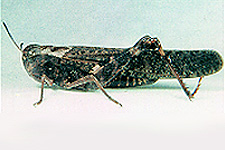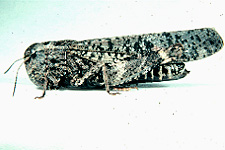Grasshoppers of Wyoming and the West
Entomology
Arphia pseudonietana (Thomas)
 |
 |
| Adult male | Adult female |
Common name - Northwestern red-winged locust (Blatchley, 1920).
Geographic distribution - British Columbia (Canada) south to Texas and New Mexico and east to Ontario, Michigan, Iowa, Nebraska, Kansas and Oklahoma (Froeschner, 1954). Colorado range is from the eastern plains to the mountain foothills (Hebard, 1929) and occasionally in western Colorado.
Habitat - dry areas with little vegetation, especially sandy or gravelly hills (Froeschner, 1954).
Food habits - a mixed feeder preferring grasses. Some of the preferred grasses are needlegrass, western wheatgrass, needleandthread, bluegrass and Junegrass. It also eats blue grama, sunsedge, sand dropseed, scarlet globemallow, crested wheatgrass and threeawn (Kumar et al., 1976; Mulkern et al., 1964; Mulkern et al., 1969; Ueckert and Hansen, 1971).
Eggs - pods contain about 20 light brown eggs arranged in two or three columns. Average egg length, 4.6 mm; average diameter, 1.2 mm (Onsager and Mulkern, 1963).
Nymph - five instars (Ramsay, 1964).
Adult - medium size. Male sometimes are nearly black. Both sexes often are greyish-brown
with many spots giving a mottled look. Face is vertical. Vertex is rounded. Antennae
are slender. Dorsal posterior margin of pronotum forms a rounded right angle. Median
carina of pronotum has a slight notch. Wings are bright red-orange. Hind femora have
pale rings near the knee. Hind tibiae are blackish with a pale ring near the knee.
Abdomen is dark, usually with pale vertical stripes. Male length, 25 mm; female, 30
mm (Blatchley, 1920; Hewitt and Barr, 1967).
Often clicks in flight. If so, flight is irregular and butterfly-like. Without clicking,
flight is direct and controlled. Flight is followed by rapid crawling on the ground.
Adults are easily frightened and constantly moving (Anderson and Wright, 1952; Blatchley,
1920).
Oviposition - eggs are laid in areas of sparse vegetation in hard clay-like soil (Criddle, 1918).
Seasonal history - overwintering occurs in the egg stage; the first instar nymphs appear in June. Adults appear in late summer (Ball et al., 1942; Mulkern et al., 1969).
Abundance and importance - eats important range grasses but rarely becomes numerous (Mulkern et al., 1969).
A. pseudonietana fact sheet from the Field Guide to Common Western Grasshoppers
Next Species: Aulocara elliotti
Previous Species: Arphia conspersa
Biology of Common Colorado Grasshoppers List
Biology of Common Colorado Grasshoppers
Grasshoppers of Colorado Contents

